Charting conversion therapy’s harrowing history – from its barbaric roots to present day cruelty
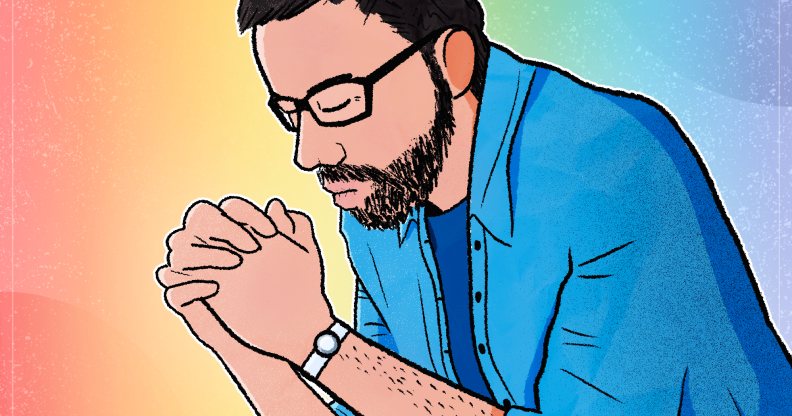
LGBT+ people have been subjected to what we now refer to as “conversion therapy” in terrifying and unsettling ways. (PinkNews)
The UK government is finally set to announce details of a conversion therapy ban after years of tireless campaigning from LGBTQ+ activists, with reports suggesting that the ban will be inclusive of trans people. But what does the barbaric practice actually entail, and where does it come from?
The Conservative government first promised a conversion therapy ban in 2018 under Theresa May’s leadership, but despite her insistence on a trans-inclusive ban, Boris Johnson later opted to push forward with legislation that only protected gay, lesbian and bisexual people from the barbaric practice.
The proposed ban, announced on Sunday (15 January) comes less than a year after Johnson attempted to scrap plans to make conversion therapy illegal altogether, before making an embarrassing U-turn less than 24 hours later.
With details of a potential ban expected to be announced in the coming days, it’s important to understand just why conversion therapy is so damaging. Here, we delve into its dark history.
What is conversion therapy?
In 1869, German psychiatrist Carl Friedrich Otto Westphal suggested that people who were experiencing same-sex attraction were suffering from a mental disorder.
Within a couple of years of the publication of Westphal’s article, some of Europe’s most influential psychiatrists had reached the same conclusion. Before long, psychiatrists began cobbling together methods that they believed might “cure” men and women of their “disordered” sexual attractions.
Over the course of the next 150 years, psychiatrists and other medical professionals carried out what we now know were experimental and highly dangerous “treatments” to rid people of their same-sex desire. Efforts to change sexual orientation and gender identity weren’t limited to the medical field either – faith groups have forced queer people to “pray the gay away”, while others have been subjected to “exorcisms” in a bid to make them more palatable to a heteronormative society.
Today, we broadly refer to efforts to change a person’s sexual orientation or gender identity as “conversion therapy” – but that term has a complex history, and it refers to a whole host of interventions that have been employed to change queer people.
Dr Chiara Beccalossi is a historian at the University of Lincoln who specialises in the medicalisation of sexuality and gender identity. She explains that psychiatrists started inventing conversion practices and “treatments” for queer people as soon as there was broad agreement that same-sex desire was a disorder.
“It started straight away,” Beccalossi tells PinkNews. “As soon as most psychiatrists in the western world agreed that homosexuality was a mental disorder, they started to ‘cure’.”
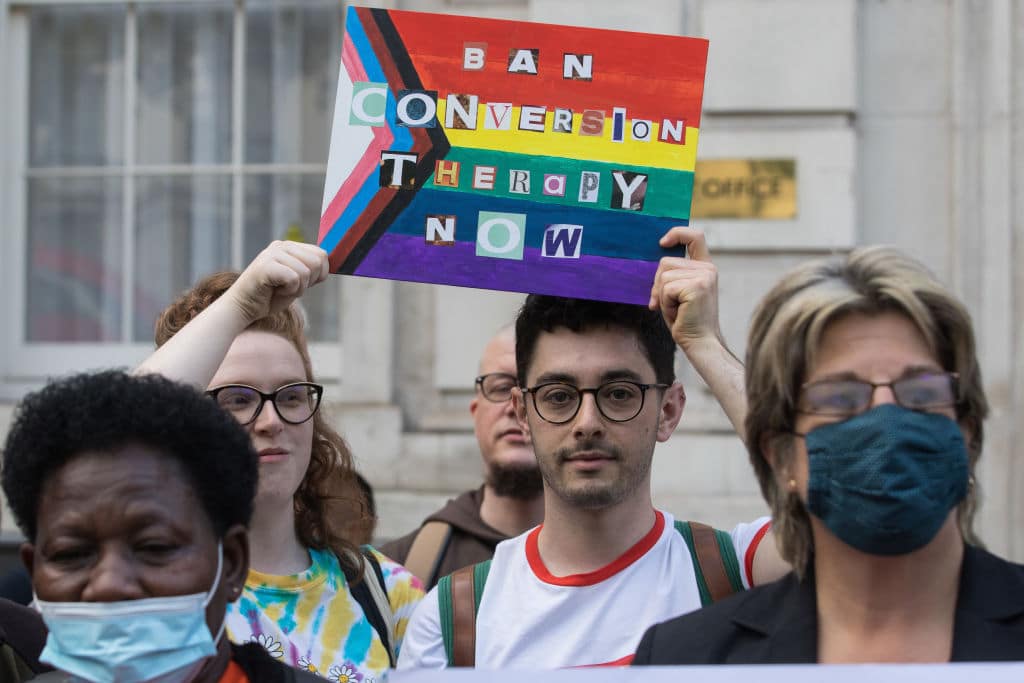
Campaigners against LGBT+ conversion therapy attend a picket outside the Cabinet Office and Government Equalities Office on 23rd June 2021 in London, United Kingdom. (Mark Kerrison/Getty)
Those efforts to “cure” queer people varied massively depending on who you were and what your position in society was.
“Initially the most invasive therapies were carried out on women, not on men,” Beccalossi explains. “At the end of the 19th century, gay women were treated with an oophorectomy – that’s where they remove the ovaries. Hysteria was treated in the same way, or there was also the cauterisation of the clitoris – basically the burning of the clitoris.”
It’s very rare to find a rich gay man or woman to be treated in this way.
These practices were almost always carried out on poor people in asylums, Beccalossi says.
“It’s very rare to find a rich gay man or woman to be treated in this way. Of course, the historical situation varies. In countries like Italy and France, male homosexuality wasn’t punished by law at the end of the 19th century, but men and women were treated for their homosexuality in asylums. In countries like Germany, Britain and so on, male homosexuality was punished by law, so men often ended up both in a prison or an asylum. But generally the most invasive practices were carried out on poor people.”
In the 1920s, psychiatrists started to dream up new and even more invasive “treatments” for queer people. One of those was hormone therapies, Beccalossi explains.
“Endocrinologists started to use hormones derived from animal products or animal glandular extracts – they extracted the hormones from the testicles or the ovaries of animals and injected them into men but also into impotent men or hysterical women or infertile women. We also have more invasive cases like the transplant of testicles. This was practiced especially in countries like Russia in the 1920s.
“In the 1940s, synthetic hormones were developed and hormone therapies became more sophisticated.” Alan Turing was eventually chemically castrated using these “treatments”.
Around the same time, scientists started experimenting with carrying out lobotomies on queer people. The procedure was used for a period of time to treat mental illness more broadly, and it resulted in permanent damage to parts of the brain’s prefrontal lobe.
‘Ghastly’ aversion therapy marked a new chapter in conversion practices
The development of aversion therapy marked a significant turning point in efforts to change queer people’s behaviours. That practice refers to a type of “behavioural therapy” in which a series of tactics, such as electric shocks, were used to deter people from acting on their impulses. The idea was that queer people would come to associate pictures of nude men, for example, with an electric shock, which would stifle their ability to become aroused. Needless to say, it was barbaric – and it was practiced in the UK right up until the 1970s.
“The men were exposed to erotic images, and while being stimulated, they were given drugs to induce vomit,” Beccalossi says. “Some were left for a few days in a room without any toilet, surrounded by their own faeces. The idea was to cause physical discomfort and associate this physical discomfort with homosexual desire.
“In some cases the physical discomfort was associated with electric shock, so you have records of gay men who had electric shocks to the genitals while watching gay pornographic images. We have records of aversion therapy going on until the 1970s, even here in Britain.”
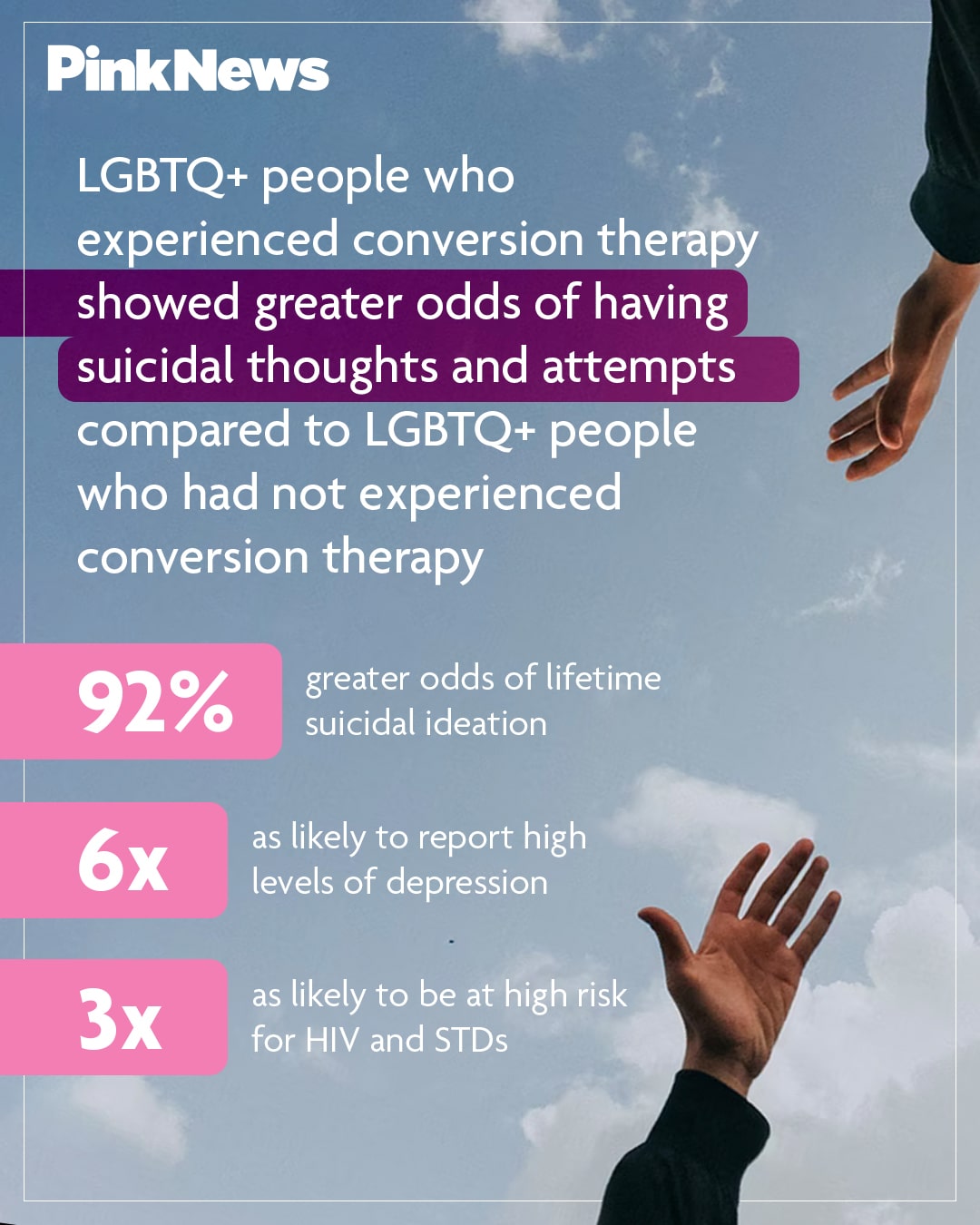
The statistics about conversion therapy show the damage the practice is still doing to this day. (PinkNews)
Dr Kate Davison, a lecturer in queer history at Goldsmiths, University of London, is keen to point out that aversion therapy and what we now know as conversion therapy aren’t exactly the same thing.
“I think most people assume that because the word sounds the same, aversion, conversion, it means that there must be some close link between the two,” she says.
“There is a link, but people forget that what we call conversion therapy these days is really an umbrella term for any kind of practice whose aim is to bring someone’s sexual or gender identity into line with mainstream normativity, so that can be exorcisms or it could be talking therapy. It could be community classes on the weekend or it could be locking someone up in a youth camp in a remote area for weeks on end and have them pray the gay away. It can mean anything, pretty much.”
Aversion therapy, she explains, was a “specific sub-branch” of psychiatry that emerged as a possible way to change a person’s sexual orientation or gender identity in the 20th century. Essentially, medical professionals saw sexuality or diverse gender expression as a “behaviour”, and they believed they could force people to develop an “aversion” to that behaviour.
“One of the findings from my research is that there is a link between conversion therapy and aversion therapy, but it’s not the smoking gun that most people think it is,” Davison says.
“Behaviour therapy is not interested in the origin or causes, it’s only interested in the symptoms. It was used for things like gambling, alcoholism, agoraphobia, eating disorders, any kind of behaviour that were considered to be impulsive and out of the patient’s control.”
In today’s world, we can see that such interventions were not only misguided, they were also cruel. Still, Davison has been fascinated to discover that the experience was a multi-faceted one for those who went through it. As part of her research, Davison has interviewed people who were subjected to aversion therapy. The actual impact of such interventions very much depended on the type of aversion therapy that was carried out, but it also depends on the person’s individual circumstances.
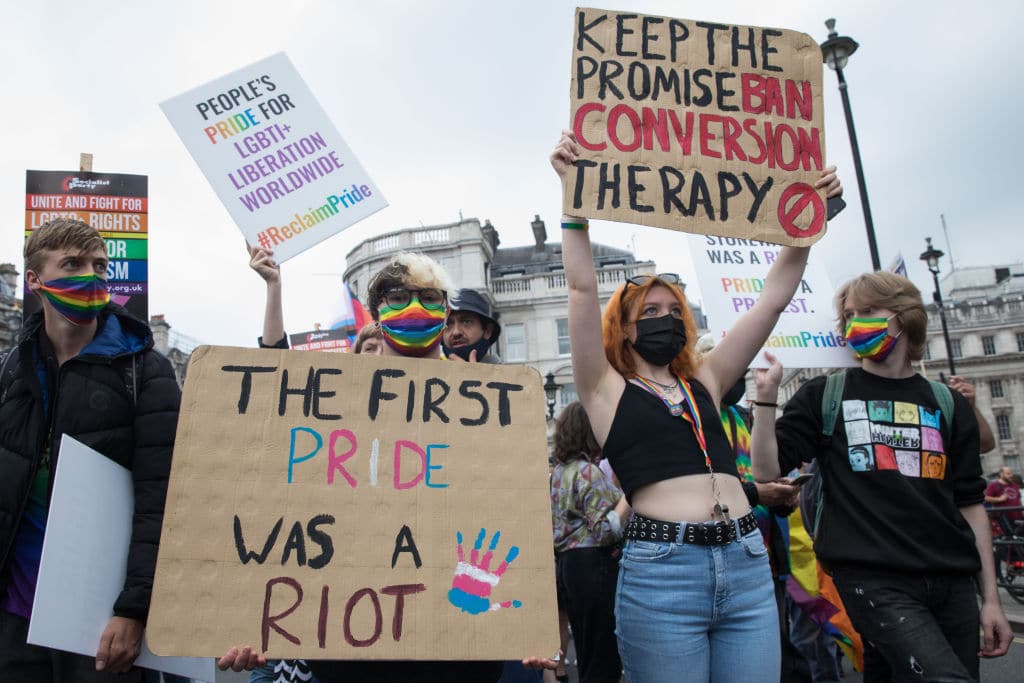
Thousands of LGBTI+ protesters pass through Trafalgar Square on the first-ever Reclaim Pride march on 24th July 2021 in London, United Kingdom. (Mark Kerrison/Getty)
The process was “ghastly”, Davison says – but not everybody experienced it in this way.
“There were patients who told me that if they hadn’t had aversion therapy, they would have killed themselves,” Davison says. “One patient told me, ‘I was in a really bad place and I thought, I’ll go and have aversion therapy and if that doesn’t work, then I’ve done everything I can and I can sleep soundly at night.’ He was a very religious person. His attitude was that if he tried aversion therapy, he had done everything he could – God can’t criticise me anymore. If this doesn’t work that’s it.
“I also spoke to another patient who told me that he found it to be an educational experience because he’d never seen porn before. He had three sessions of aversion therapy, and as soon as the psychiatrist showed him pictures of men, he thought, ‘Oh my god, I didn’t know this stuff existed.’ And he walked away quite happy because he suddenly had had an education and he knew exactly what he wanted.”
Davison’s research has made her realise how important it is that we move away from a “victim” narrative when we talk about conversion practices like aversion therapy.
“It’s not always accurate or correct, and it doesn’t always reflect people’s experiences that I learned about through my research.”
Religious conversion practices are ‘just as old as the medical’
Conversion practices weren’t just carried out by psychiatrists – those in the know will be well aware that religious organisations have been offering services for years that claim to “counsel” people through their same-sex desire or their gender exploration. In the United States, throughout the 1980s and 1990s, young people were sent to camps where they would pray to be freed from their sexual desire. Religious organisations all across the world continue to offer these discredited interventions to this day.
Jayne Ozanne is a survivor of faith-based conversion therapy. She says such practices have been going on “for years” and that it’s “just as old as the medical”.
Some of us have been banging and banging this drum for years that it’s not just a medical therapy.
“It all comes from the belief that the only acceptable way of living and being is heteronormative, cisgender stereotypes of male and female. Anything and everything that’s different to that has been subject to ‘healing’ for years, but the growth of the charismatic movement in the ‘70s and ‘80s, which meant that people were experiencing what they called gifts of the holy spirit… it sort of empowered a lot of people to believe that actually there is a way of casting out demons and healing people and getting the holy spirit to give you knowledge as to why you’re gay.”
The result was “a perfect storm” for religious conversion practices to proliferate, Ozanne says. People were much more free to express their sexuality and their gender identity than ever before, and religious groups were becoming increasingly emboldened to use “gifts” of the holy spirit to try and change them.
Such practices are still going on to this day – in fact, research suggests the most common form of conversion therapy in the UK today is done in religious settings, usually behind closed doors. The result is that few people are even aware that such efforts are ongoing.
We spoke to Ozanne in February 2022, before Boris Johnson’s double U-turn on a conversion therapy ban.
At the time, Ozanne said she was growing increasingly frustrated by the UK government’s reluctance to recognise just how harmful religious conversion therapy is. She was also tired of waiting for the government to ban the practice.
“Some of us have been banging and banging this drum for years that it’s not just a medical therapy,” Ozanne said.
Research shows that survivors of such practices go on to experience suicidal ideation, eating disorders, and other mental health issues, she added.
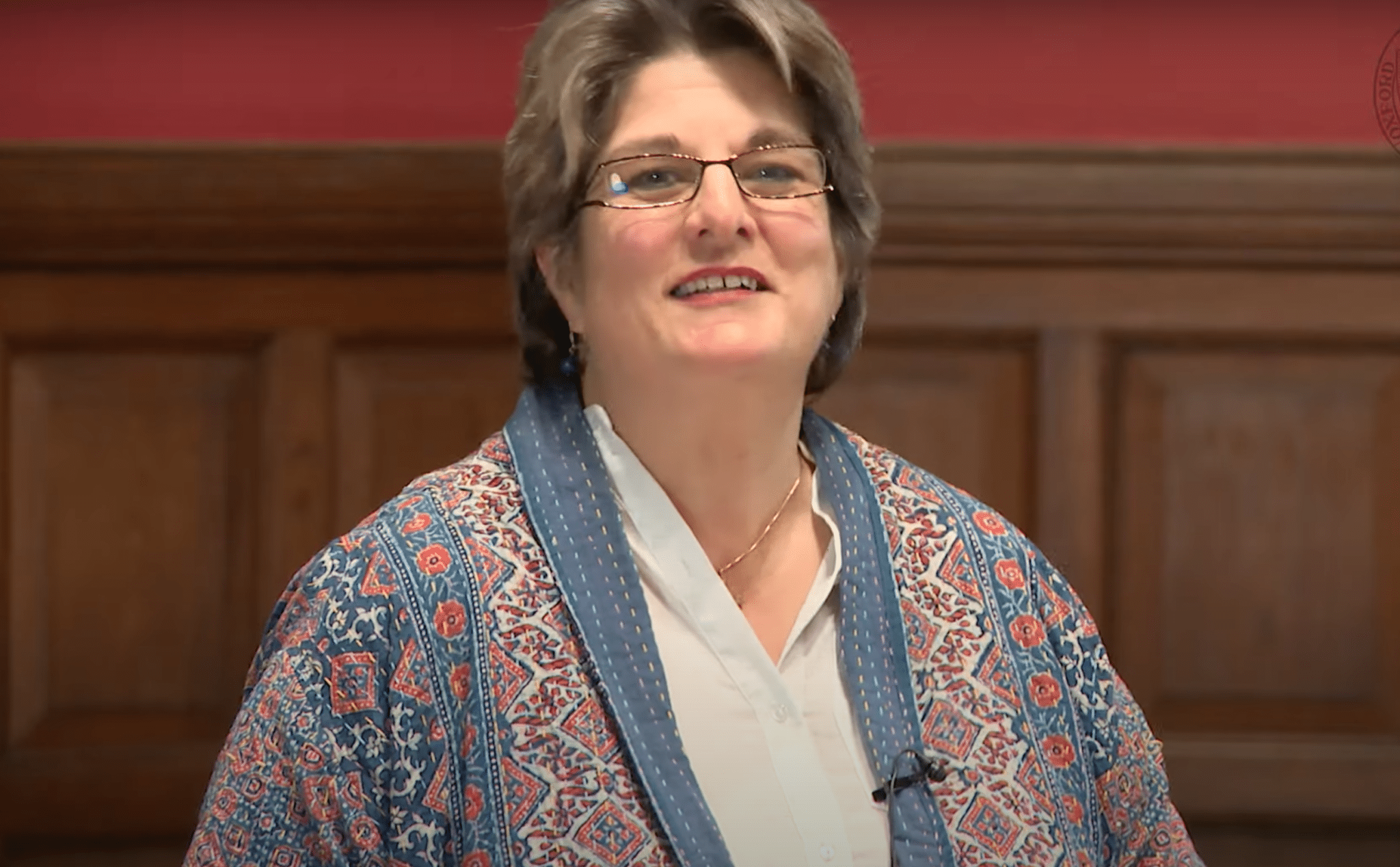
Jayne Ozanne has been featured on ITV and the Acting Prime Minister podcast speaking about her experiences with conversion therapy. (YouTube/OxfordUnion)
Ozanne says governments need to send a clear signal that conversion therapy is “unacceptable, dangerous and damaging”. That’s why it’s so important that the process is banned in its entirety.
“Banning it is the first major important step, because it says as a civilised society, this is what is acceptable and this is what’s not acceptable, and we must protect the vulnerable. Sadly we know from the research that over half of those going through conversion therapy right now are children, and another third are young adults. They need protecting. We need to ensure that we have provisions that allow us to step in and protect kids at the start of their lives from stuff that will damage them forever.”
Banning conversion therapy likely won’t end the practice overnight, however. Davison believes we need to do more than just outlaw conversion therapy on paper if we want to truly protect queer people from harm.
“Introducing a law to ban those practices is an important step and it sends an important message that the community as a whole finds these practices abhorrent, but in terms of actually a practical effect of stopping these practices, I remain a little sceptical about whether that’s actually going to work,” Davison says.
“I think we need a much bigger community response, not just introducing a legal statute outlawing these practices, but also a bigger community response that is about celebrating sexual and gender diversity. I think that’s really the only thing that’s going to help us to stamp these things out.”
Readers affected by the issues raised in this story are encouraged to contact Samaritans free on 116 123 (www.samaritans.org) or Mind on 0300 123 3393 (www.mind.org.uk). Readers in the US are encouraged to contact the National Suicide Prevention Line on 1-800-273-8255.

